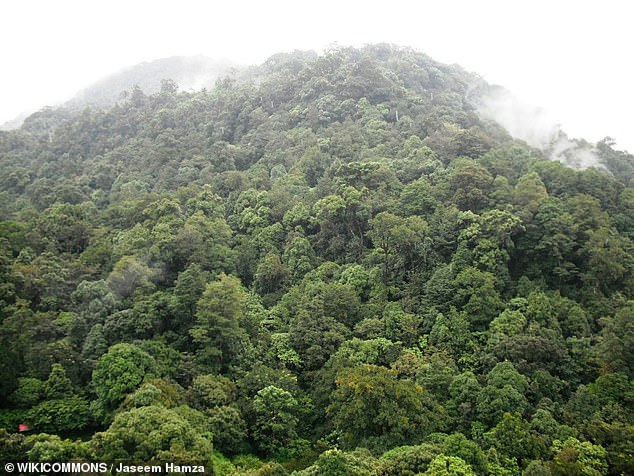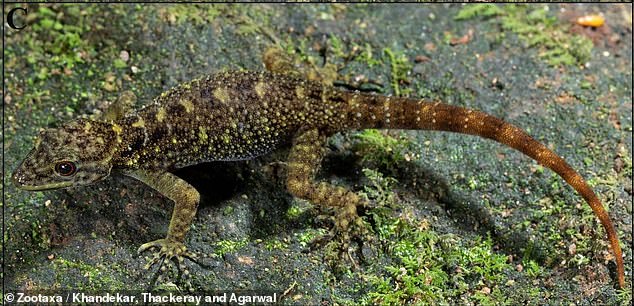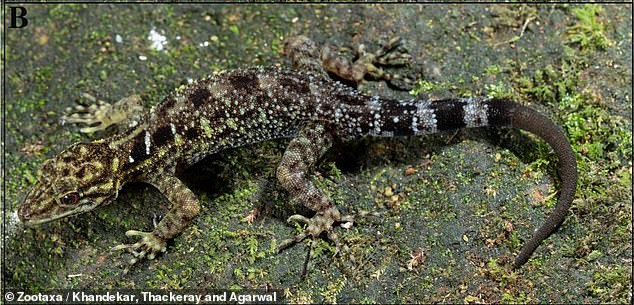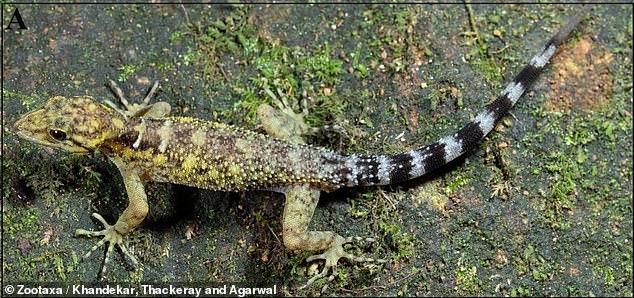A scaly creature with long fingers and red eyes, discovered in the evergreen forests of India, has been confirmed as a new species.
Biologists performed DNA analysis on an unusually large gecko they found wandering nearly 4,600 feet above sea level on the Valparai Plateau in the southwestern part of the country.
The gecko, now officially called the ‘Valparai dwarf gecko’, lives almost exclusively in ‘rock habitats in evergreen forests in Tenkasi’, a region that is home to some of the most important spiritual and cultural sites in India.
But the team also found four more new species of gecko, all from the same common ancestor, and each maintaining their own tiny habitats high in India’s tropical evergreen forests.
New DNA analysis has confirmed that an unusually large gecko with red eyes (pictured), which was found in a high-altitude evergreen forest in India, is a genuine new species.

Above, an example of Indian evergreen forests in the region near where the new gecko species was found. This mist-shrouded forest is located in the Silent Valley National Park, one of the last intact parts of the Southwestern Ghats of India, with its high-altitude evergreen tropical forests.
The phenomenon of a species evolving to fit a very small niche in an equally small habitat is called “extreme microendodemism.”
And all 23 known species of this form of gecko are known to be similarly confined to their small local ecosystem.
The new Valparai dwarf geckos were classified as large for this family of lizards, but they reach only about 4.5 inches in length, according to the new study published in June in the peer-reviewed journal. zootaxa.
The Valparai dwarf was identified as a new species first by its unique red eyes, its scale color and pattern, the position of its numerous quills, and the long fingers visible on its claws.
But at a less visible microscopic level, DNA testing of the Valparai dwarf specimens showed that the lizards were more than eight percent different genetically than their fellow dwarf geckos.

The female Valparai dwarf specimen appeared to be overall “much darker,” according to the researchers, with “less prominent yellow coloration.” The female also appeared to have an orange-brown tail (pictured above).

A male specimen of the Valparai dwarf gecko (pictured above) had a dull brown section of tail where the appendage had been cut off and regenerated.
The geckos were found in a cave on the outskirts of Tenkasi, perched on rocks near a road, one of the region’s many temples and a tea plantation.
The lizard’s range is estimated to include an elevation of between 3,900 and 4,600 feet.
Samples of the Valparai dwarf gecko showed striking color variation within this new species.
The three Valparai specimens have a “yellowish brown” coloration, but the two male specimens had darker “black and white” regions throughout their tales.
One male dwarf gecko specimen had its sides dotted with bright yellow spots, while the other had a dull brown tail section from which the appendage had been severed and then regenerated or grown back.
The female Valparai dwarf specimen appeared to be overall “much darker,” according to the researchers, with “less prominent yellow coloration.” The female also appeared to have an orange-brown tail.
The study’s three co-authors, working with the Thackeray Wildlife Foundation and Shivaji University in India, also identified four more new and closely related dwarf gecko species.
Called the Agamalai dwarf gecko, Anaimalai dwarf gecko, Anuradha dwarf gecko and Tenkasi dwarf gecko, these new species had a genetic divergence between 5.4 and 2.3 percent apart from each other, the researchers said.
In keeping with all of these hyperlocal and rare gecko species, the research team also noted that there were three more “non-sister species” of gecko, in addition to the total of 23 known, living in a straight line within a mile of each other. in the protected Anaimalai Tiger Reserve of the Valparai Plateau.


